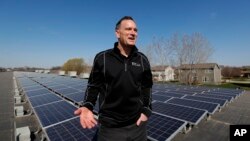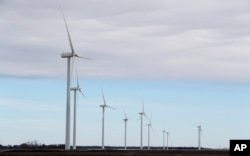When Todd Miller began his two-person solar installation business in a suburb of Des Moines, one of the challenges he faced was keeping up with customer orders, as tax incentives and plunging prices for the boxy roof panels created a booming demand for this form of clean energy.
Four years later, Miller's company has grown to 14 employees, but now he faces a real obstacle: action in the state Legislature that he says could put solar companies out of business.
The threat is coming from an unlikely source, a utility known as an alternative energy champion for its installation of thousands of wind turbines across the landscape. The wind energy darling is pushing lawmakers to tack on an extra cost to future solar customers, even if doing so makes solar energy economically uncompetitive.
“Everything should be lined up for the best year we've ever had,” Miller said. “Instead, it's been a lot of sleepless nights.”
For years wind and solar were friendly twins in the campaign for green alternatives to fossil fuels, but the relationship is getting ugly in a number of states, especially in Iowa, where more than 4,000 turbines generate 34 percent of the state's electricity, the second highest rate in the country.
About half of those turbines were installed by Des Moines-based MidAmerican Energy, a wind energy leader that proudly notes its towering blades spin enough power to equal its customer demand. The utility has taken aim at a growing solar industry made up of dozens of small companies across the state.
The acrimony comes as alternative energy sources are powering an increasing percentage of the country's needs. Since 1990, the country's wind energy capacity has grown from a tiny 0.2 percent to 6.5 percent in 2018, and in the past decade solar capacity has had an average annual growth rate of 50 percent. About 2 million solar systems have been installed on homes and businesses nationwide, with 3,700 in Iowa.
As alternative energy becomes more popular, the questions are growing about the appropriate level of tax incentives and other rules designed to jumpstart such power sources.
MidAmerican has received billions of dollars in federal tax credits to build its wind farms. With those incentives being phased out, MidAmerican and other utilities are now challenging the special perks that solar receives. The federal tax credits covering solar installation costs will decline in the coming years, ending for residential in 2022 and sticking at 10 percent for commercial projects.
A key to solar's recent success in Iowa and many states is that when panels produce excess energy, state law requires it be sold to utilities at a premium price. Solar advocates argue that if the price is lowered or other fees added, as MidAmerican has proposed, the foundation of the industry's expansion is threatened.
“At a time when we're being ravaged by extreme weather events that are the result of a warming planet and climate change, we should be thanking people, businesses, farmers and homeowners that have taken it upon themselves to produce some carbon-free energy where they live and work,” said state Sen. Joe Bolkcom, a Democrat and advocate for alternative energy. “We should be thanking people for doing more of that, not trying to kill all the jobs and undermine the good work that's gone on across the state.”
MidAmerican has pushed hard for the measure in the Legislature that would require a homeowner with an average solar array to pay about $27 a month, cutting deeply into the savings customers see if they install a system at a cost of $30,000 or so.
While energy savings vary regionally, advocates contend that solar systems can roughly pay for themselves over 25 years.
The state Senate has approved the measure, mainly with Republican votes. It's awaiting action in the House, but is opposed by legislators who note farmers are enduring tough times and that new fees would deprive them of an option for saving money.
MidAmerican argues the new fees would go toward maintenance of the electrical grid, which solar customers use when they sell excess power back to the utility.
“It's about customer fairness,” MidAmerican spokeswoman Tina Hoffman said. “Paying for the grid if you use the grid is what this policy is about.”
Utilities across the U.S. have made similar arguments when they proposed increasing fees to solar customers or paying less for their excess power. While about 20 states have approved rules encouraging solar, Republicans in many states often have been sympathetic to utility arguments that tax breaks simply shift costs to other customers.
MidAmerican is a big contributor to both Republican and Democratic politicians in Iowa, and the state takes pride in the utility's success in making Iowa a wind energy mecca.
In Maine, utilities also lobbied for measures that would make solar less attractive economically. Then-Gov. Paul LePage, a Republican, backed the moves, but new Democratic Gov. Janet Mills reversed his actions this year.
Kansas regulators in 2018 eliminated much of the cost savings for solar users who sell back extra power. In Indiana, utilities gained passage of a bill that reduced the rate solar customers were paid for excess power, prompting a giant drop in panel installations. It was a similar story in Nevada in 2016, but a backlash prompted lawmakers to quickly make a U-turn.
Miller, who operates his solar business in the Des Moines suburb of Ankeny, said he thinks the issue is less about fairness and more about a profitable utility eager to limit competition and dominate solar as it now does wind power. Last year, MidAmerican reported a profit of $682 million.
Miller noted that at a legislative hearing, a MidAmerican lobbyist promised that the utility would use the additional fee to invest in large-scale solar projects.
“They're using that as the stepping stone to take over any and all solar,” Miller said. “If energy is being produced, they want to produce it.”
Nationally, utilities are increasing investment in solar and in 2018 were responsible for more than half of new installations, according to the Solar Energy Industries Association.
Ashley Brown, who leads Harvard University's Electricity Policy Group, said state authorities who oversee private utilities could step in if they believe companies are pushing out smaller competitors. But Brown argues that users shouldn't expect a free ride on infrastructure owned by utilities.
“The people who want to use the system should have to pay for it,” he said.








